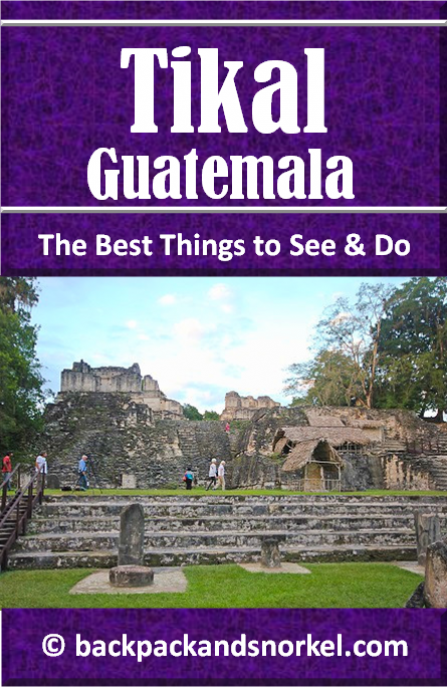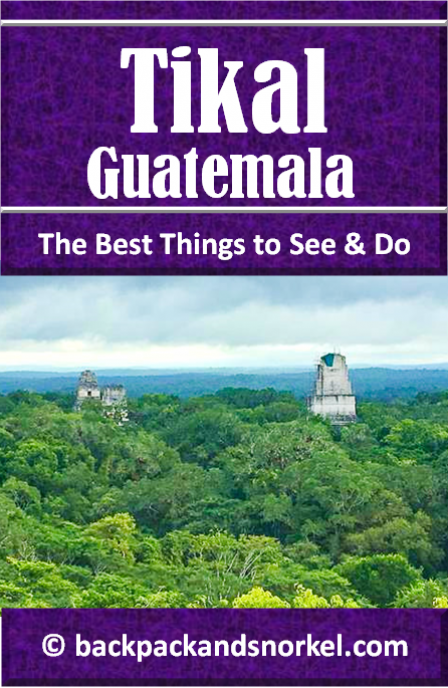THE MAJOR TEMPLES IN TIKAL - Tikal Purple Travel Guide
The major temples are the main attractions in Tikal. We tell you what you can see here and we have lots of background information and photos so you understand what you will see.
TEMPLE I
A description of Temple I can be found here.
TEMPLE II
A description of Temple II can be found here.
TEMPLE III
Temple III is also called the Temple of the Jaguar Priest. The name comes from finely sculpted lintel on the inner doorway representing an obese figure wrapped in a jaguar skin. Unlike in other temples, there are only two chambers in the summit shrine and not 3.
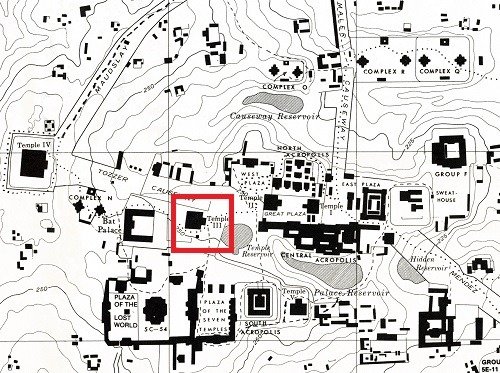
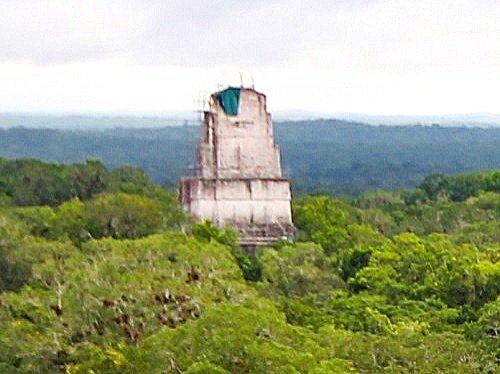
Temple III is 180ft (55m) tall, has nine stepped levels, an east-facing access stairway and was built in 810AD. It is the last pyramid temple that was built in Tikal and its presence indicates that Tikal must have still been politically stable at that time.
Temple III is associated with king Dark Sun of whom very little is known. It is assumed that this temple contains Dark Sun’s tomb, but as the temple has not yet been archaeologically investigated, the tomb has not been found. The temple is only partially restored and closed to the public.
Back to the Self-Guided Walking Tour of Tikal
TEMPLE IV
Built in 741AD, this partially restored east-facing Mesoamerican pyramid is the tallest structure in the entire Maya empire and it is one of the few pyramids you are allowed to climb on a designated and safe path.
It is believed that this temple if the burial place of king Yik'in Chan K'awiil. His tomb has not yet been found, but it may lie somewhere underneath the temple.

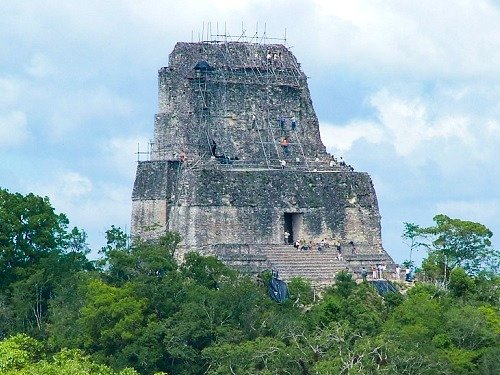

The base of the rectangular pyramid is oriented in north-south direction. It is estimated that this 212ft (64.6m) pyramid used 6.7mio cubic feet (190,000m3) of stone.
The pyramid stands on a 472 x 354ft (144 x 108m) supporting platform which is accessed by a 144ft (44m) wide stairway.
The lowest of the seven stepped levels measures 289 x 213ft (88 x 65m) and the uppermost platform is 126 x 64ft (38.5 x 19.6m).
The massive 42ft (12.9m) tall roof comb was built on the highest part of the structure's rear and faced with a huge mosaic sculpture. It has three distinct levels with four internal chambers on each level on the inside.
The summit shrine measures 105 x 40ft (31.9 x 12.1m) and is 29ft (8.9m) tall, excluding the roof comb. As usual for Tikal, the shrine had three chambers and each was behind the other. Each chamber was connected to the next by a doorway with a lintel made from sapodilla wood. Also, as usual, the lintel of the exterior doorway was plain but the two interior lintels were intricately carved. The two interior lintels are now at the Ethnographic Museum in Basel, Switzerland.


Does this view look familiar to you?
If you say yes…I am impressed. The view from Temple IV in Tikal was used in a short sequence where the Millennium Falcon lands on the rebel base on moon Yavin 4 in the first Star Wars film: Episode IV: A New Hope, which premiered in 1977.
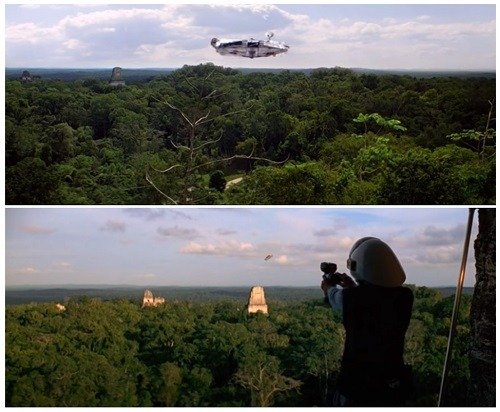
Source: Kurtz, Gary (Producer), & Lucas, George (Director). (1977). Episode IV - A New Hope [Motion picture]. United States: Lucasfilm.
The Star Wars scene can be seen here.
Back to the Self-Guided Walking Tour of Tikal
TEMPLE V
Built around 700AD, this temple is 187ft (57m) tall, which makes it the second tallest structure at Tikal.

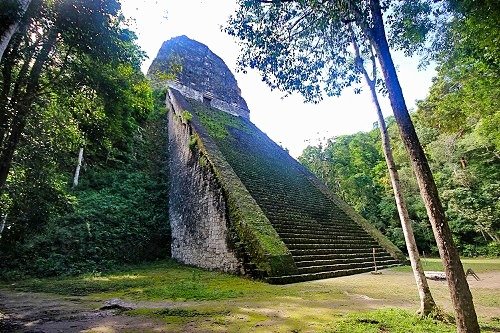

The base of the pyramid covers an area of about 22,100 square feet (2,050m2). The base of the pyramid is 118 x 167ft (36 x 51m). Temple V is the only major temple in Tikal that has rounded corners.
The main stairway is 66ft (20m) wide and is located in the north. This is also unusual for Tikal as most of the larger temples either face east or west.
The summit shrine is unique too as it only contains a single small room that is 3ft (90cm) deep, while its the rear wall is a massive 15ft (4.6m) thick. The room is 13ft (4m) wide and 14ft (4.4m) high and that makes it the smallest room of any shrine in Tikal. The original wooden lintels are still in the shrine and its cornice is decorated on the north side with three masks of the rain god Chaac and human figures on the sides.
It is theorized that the temple was either dedicated to the rain god Chaac, or that it was the burying place of a king who idolized Chaac, based upon the large Chaac masks and the fact that the temple faces Tikal’s the water reservoir, the city’s greatest source of water.
Some archeologists believe that the oldest son of king Jasaw Chan K'awiil I, who likely died shortly after coming to power in 734AD, may be interred here.
Excavations of the platform have revealed that construction may have begun between 550 and 650AD.
Compared to other temples in Tikal, Temple V is in a much worse condition and it is not connected to the city's network of causeways like other major temples. The possible explanation for this is that the temple may have been abandoned early, because access to the temple was hindered in the north by a depression that was used as one of Tikal's water reservoirs, in the west by the South Acropolis, by a palace complex to the east and a natural depression in the terrain to the south.
There is no sign that the temple was built in more than one construction phase and that it was not superimposed upon an earlier building. That strengthens the theory that the temple was abandoned and not of interest for any later rulers.
So far, two burials have been found:
Burial 1
The skeleton of an adolescent female who was approximately 15 years old was found placed in a fetal position. Her teeth were decoratively perforated and it is believed that she may have died from a tooth infection. An earthenware bowl was found near her right knee.
Burial 2
This unusual burial was discovered when archaeologists tunneled underneath the pyramid. They found a 1.5 x 2.3 x 1.1ft (0.5 x 0.7 x 0.35M) cist carved into the bedrock which was covered by a wooden plank (instead of the usual stone lid) with two ceramic vessels on top.
Also unusual is that the cist was not located under the central axis of the pyramid but under the central axis of the summit shrine.
The burial was accompanied by funerary offerings that included an earthenware bowl containing a ceramic incense burner that were placed on top of the wooden lid closing the cist.
The person who was buried here was a young male between 18 and 22 years of age. His skull was elongated and his teeth were filed and perforated. Some pyrite incrustations from the fillings were found in the lower jaw.
Many of the smaller bones, like some hand and spine bones, were missing.
The cist also contained ashes at the bottom and small carbon fragments which could be evidence of a ritual that was performed before the human remains were inserted into the cist. There was speculation that this person may have been a human sacrifice, but this is unlikely there were few signs of cutting marks on the bones and it would be unusual to dedicate a temple to a sacrificed person.
It is believed that the cist was built after the terrain was artificially leveled and before the pyramid was built.
The date of burial is believed to be between 600 and 650AD. Due to the relatively poor offerings in the burial, it is not believed that this person was one of the rulers of Tikal.
Back to the Self-Guided Walking Tour of Tikal
TEMPLE VI
This structure is also known as the Temple of the Inscriptions. It represents a Mesoamerican pyramid which faces west towards a walled plaza. The three west-facing entrance doors and interior layout suggest that Temple VI was actually a palace rather than a temple.

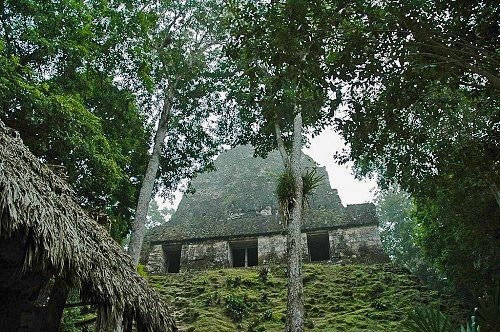
Source: mtsrs, photo resized and enhanced, license
The roof comb of the temple has hieroglyphic inscriptions on the sides and back which tell the history of Tikal. The oldest inscription is for 1139BC and it shows either a mythical event or an event of historical importance that has been told through generations of Mayan people and was finally recorded here.
The pyramid's summit contains two chambers instead of the typical three. The roof comp is damaged and eroded and its highest surviving portion stands 40ft (12m) tall.
Back to the Self-Guided Walking Tour of Tikal
What do you want to explore now?
Other popular Purple Travel Guides you may be interested in:
Like this Backpack and Snorkel Purple Travel Guide? Pin these for later:

